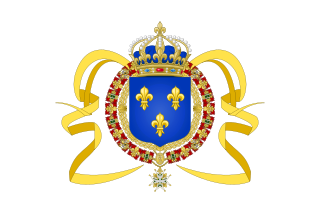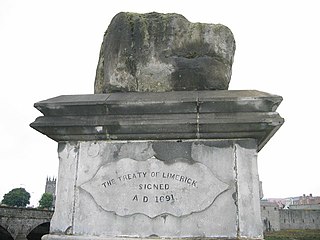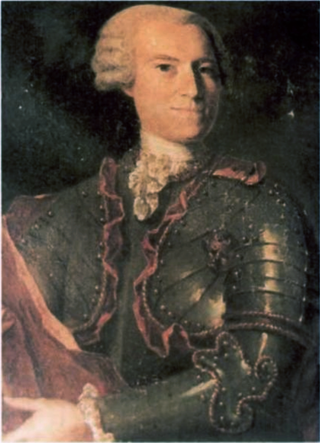
Bordeaux is a city on the river Garonne in the Gironde department, southwestern France. A port city, it is the capital of the Nouvelle-Aquitaine region, as well as the prefecture of the Gironde department. Its inhabitants are called "Bordelais" (masculine) or "Bordelaises" (feminine). The term "Bordelais" may also refer to the city and its surrounding region.

Nantes is a city in Loire-Atlantique of France on the Loire, 50 km (31 mi) from the Atlantic coast. The city is the sixth largest in France, with a population of 320,732 in Nantes proper and a metropolitan area of nearly 1 million inhabitants (2020). With Saint-Nazaire, a seaport on the Loire estuary, Nantes forms one of the main north-western French metropolitan agglomerations.

Saint-Domingue was a French colony in the western portion of the Caribbean island of Hispaniola, in the area of modern-day Haiti, from 1697 to 1804. The name derives from the Spanish main city on the island, Santo Domingo, which came to refer specifically to the Spanish-held Captaincy General of Santo Domingo, now the Dominican Republic. The borders between the two were fluid and changed over time until they were finally solidified in the Dominican War of Independence in 1844.

Nicolas Thomas Baudin was a French explorer, cartographer, naturalist and hydrographer, most notable for his explorations in Australia and the southern Pacific. He carried a few corms of Gros Michel banana from Southeast Asia, depositing them at a botanical garden on the Caribbean island of Martinique.

The Treaty of Limerick, signed on 3 October 1691, ended the 1689 to 1691 Williamite War in Ireland, a conflict related to the 1688 to 1697 Nine Years' War. It consisted of two separate agreements, one with military terms of surrender, signed by commanders of a French expeditionary force and Irish Jacobites loyal to the exiled James II. Baron de Ginkell, leader of government forces in Ireland, signed on behalf of William III and his wife Mary II. It allowed Jacobite units to be transported to France, the diaspora known as the Flight of the Wild Geese.
Jacques-Alexandre Laffon de Ladebat was a prominent shipbuilder and merchant of the port of Bordeaux in the late 18th century. His son, André-Daniel Laffon de Ladebat, succeeded him, and later became involved in politics. In 1789, he participated in the French Revolution.

The Williamite War in Ireland took place from March 1689 to October 1691. Fought between supporters of James II and his successor, William III, it resulted in a Williamite victory. It is generally viewed as a related conflict of the 1688 to 1697 Nine Years' War.

The Battle of Aughrim was the decisive battle of the Williamite War in Ireland. It was fought between the largely Irish Jacobite army loyal to James II and the forces of William III on 12 July 1691, near the village of Aughrim, County Galway.

The siege of Limerick in western Ireland was a second siege of the town during the Williamite War in Ireland (1689–1691). The city, held by Jacobite forces, was able to beat off a Williamite assault in 1690. However, after a second siege in August–October 1691, it surrendered on favourable terms.

Jean-Baptiste du Casse was a French naval officer, privateer, slave trader and colonial administrator who served as the first governor of Saint-Domingue from 1691 to 1700. Born on 2 August 1646 in Saubusse, France to a Huguenot family, du Casse enlisted in the French merchant navy before joining the French East India Company and the Compagnie du Sénégal. He subsequently enlisted in the French Navy and took part in several victorious expeditions during the Nine Years' War in the West Indies and South America.
Charles Chalmot de Saint-Ruhe was a French cavalry officer, serving in the armies of Louis XIV.
Pierre Lafitte (1770–1821) was a pirate in the Gulf of Mexico and smuggler in the early 19th century. He also ran a blacksmith shop in New Orleans, his legitimate business. Pierre was historically less well known than his younger brother, Jean Lafitte. While not as much of a sailor as Jean, Pierre was the public face of the Lafitte operation, and was known for his wit and charm, in addition to his handling of the sale of smuggled goods.
Mary O'Shiell, was a French-Irish privateer shipowner and slave trader. She is a known figure in the history of Nantes, alongside her sisters Agnés O'Shiell and Anne O'Shiell.

Antoine Vincent Walsh was a French merchant, ship owner and slave trader of Irish descent who operated in Nantes. Born into an expatriate Irish family who had settled in Nantes, France, his support for Jacobitism led Walsh to assist Charles Edward Stuart during the Jacobite rebellion of 1745.

Anne O'Shiell was a French businesswoman. She managed the major slave trade firm Grou et Michel in Nantes from 1774 to 1793, which at that time was one of the most successful companies of its kind, making her a millionaire.

The Nantes slave trade resulted in the deportation, from the late 17th to the beginning of the 19th century, of more than 500,000 black African slaves into French ownership in the Americas, mainly in the Antilles. With 1,744 slave voyages, Nantes, France, was the principal French slave-trading port for the duration of this period. The slave trade was explicitly encouraged by the royal family and described by the church as an "ordinary occupation."

Jean-Baptiste Mac Nemara, baron du Mung, seigneur de la Rochecourbon, Tourfou, Moullet et autres lieux was a French Navy officer of Irish origin.

The Marie Séraphique was a late 18th-century slave ship that made six slave voyages out of Nantes, France. There are two illustrations of the ship that show how captives travelled, believed to have been painted by the captain and second lieutenant. There is a diagram showing densely-packed shackled slaves on the ship, and a painting showing slaves being sold aboard.

Saint-Domingue Creoles or simply Creoles, were the people who lived in the French colony of Saint-Domingue prior to the Haitian Revolution.













